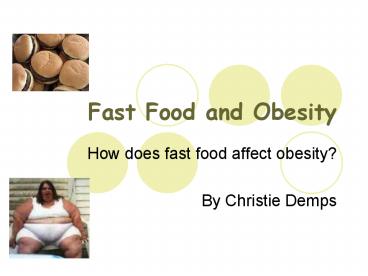Fast Food and Obesity PowerPoint PPT Presentation
1 / 15
Title: Fast Food and Obesity
1
Fast Food and Obesity
- How does fast food affect obesity?
- By Christie Demps
2
Fast Paced Lives
- There is a high demand for speedy
serviceshigh-speed internet, fast drying nail
polish, fast computers, digital cameras, etc. - Fast food
3
What I Will Discuss
- Overview of obesity. What is it? Its Prevalence
in the U.S. - Overview of fast food. What is it? Why do we
consume so much as Americans? What is the problem
with it? - A study discussing the energy density of fast
food and how this affects weight gain leading to
obesity. - Why is studying the affects of fast food on
obesity important? Changes that have begun to be
made and can be made in the future to help
alleviate the problem.
4
What is Obesity?
- The condition of being obese increased body
weight caused by excessive accumulation of fat.
(BMIgt30)
5
Prevalence of Obesity in the U.S.
- According to the National Center for Health
Statistics, the Prevalence of Overweight and
Obesity Among Adults in the United States has
doubled between 1976 and 2002 (15-31).
6
What is Fast Food?
- Low in nutrients. High in fat, calories, sodium,
and/or sugar - Easy consumption
7
Why do we eat fast food?
- Taste
- Prices for fast food are significantly cheaper
than fresh food. - The Media
- TV-Commercials are filled with advertisements
promoting fast food. - Newspapers- Contain coupons for sales on fast
food. - Convenience
8
Why is studying fast food and obesity important?
- We as Americans consume so much. If fast food
does have an affect on obesity, then the
consumption of it can cause us to have many
health related problems such as heart disease.
9
The Study
- MRC International Nutrition Group, London School
of Hygiene and Tropical Medicine, UK. - Reviewed a series of studies to demonstrate that
the energy density of food is a key determinant
of energy intake.
10
The Study Continued
- Collected food composition information from
leading fast food chains - Energy density avg. 1100 kJ /100 g -1
- British foods- 525 kJ/ 100 g -1
- African foods- 450 kJ/ 100 g -1
- 3 Experiments altering the amount of fat each
group consumes
11
The Data
- 3 Experiments
- Exp.1- 7 day High fat diet
- Exp. 2.- 7 day Low fat diet
- Exp. 3- Energy density held constant
12
The Results
- Exp. 1 and 2- Spontaneously ingested more energy
on the diet of high energy density and less than
that on the low energy density. (High-fat
Hyperphagia) - Exp. 1- Gained 65g fat/day
- Exp. 2- Lost weight
- no physiological or behavioral compensation by
the end of day 7 on either - Exp. 3- High fat hyperphagia was abolished
13
What does all of this tell us?
- In summary, physiological experiments illustrate
the potency by which energy-dense diets can
undermine the normal processes of appetite
regulation in humans. This failure of
physiological regulation causes an accidental
positive energy balance.
14
The Future
- Suggestions for improvement
- to provide and promote a wider range of healthy
options with low energy density - to take steps to reduce the energy density of
menu items across the board (usually achievable
by reducing the fat content) - to provide clear listings of nutritional
composition (especially energy and fat) at
point-of-purchase and on packaging - to stop encouraging inappropriately large portion
sizes through advertising, manipulative price
structures and pressure selling of additional or
larger menu items.
15
References
- U.S. DEPARTMENT OF HEALTH AND HUMAN
SERVICESCenters for Disease Control and
PreventionNational Center for Health Statistics - http//www.cdc.gov/nchs/products/pubs/pubd/hestats
/obese/obse99.htm - Fast foods, energy density and obesity a
possible mechanistic link. A. M. Prentice1 and S.
A. Jebb2. Obesity ReviewsVolume 4 Issue 4 Page
187 - November 2003

